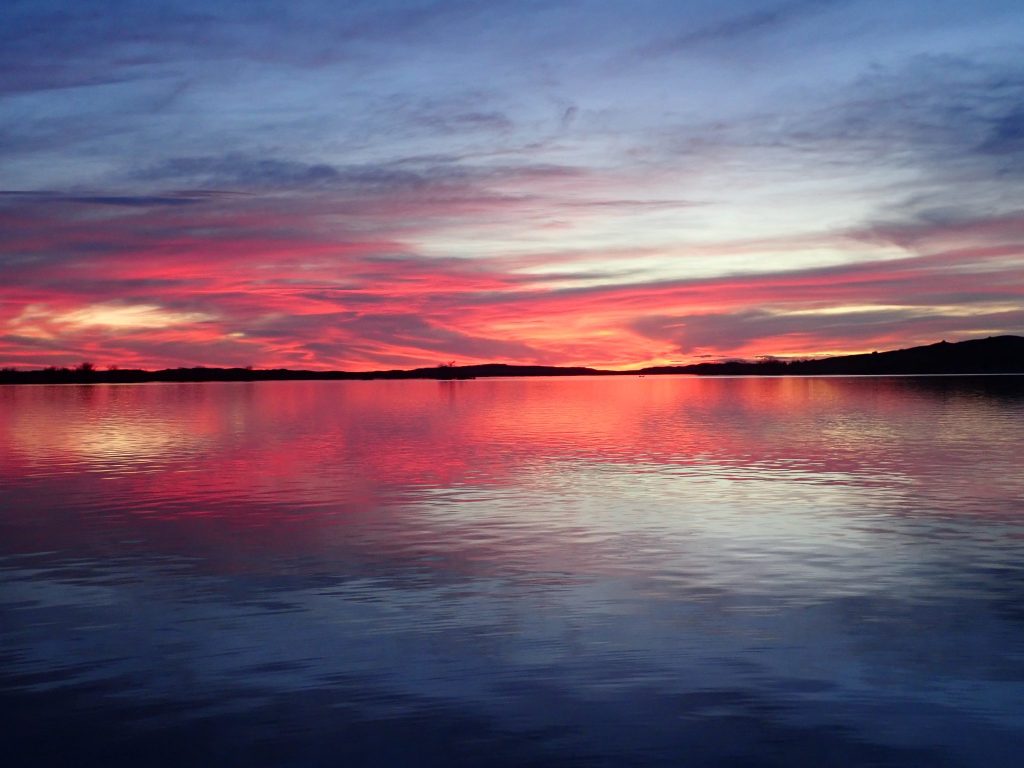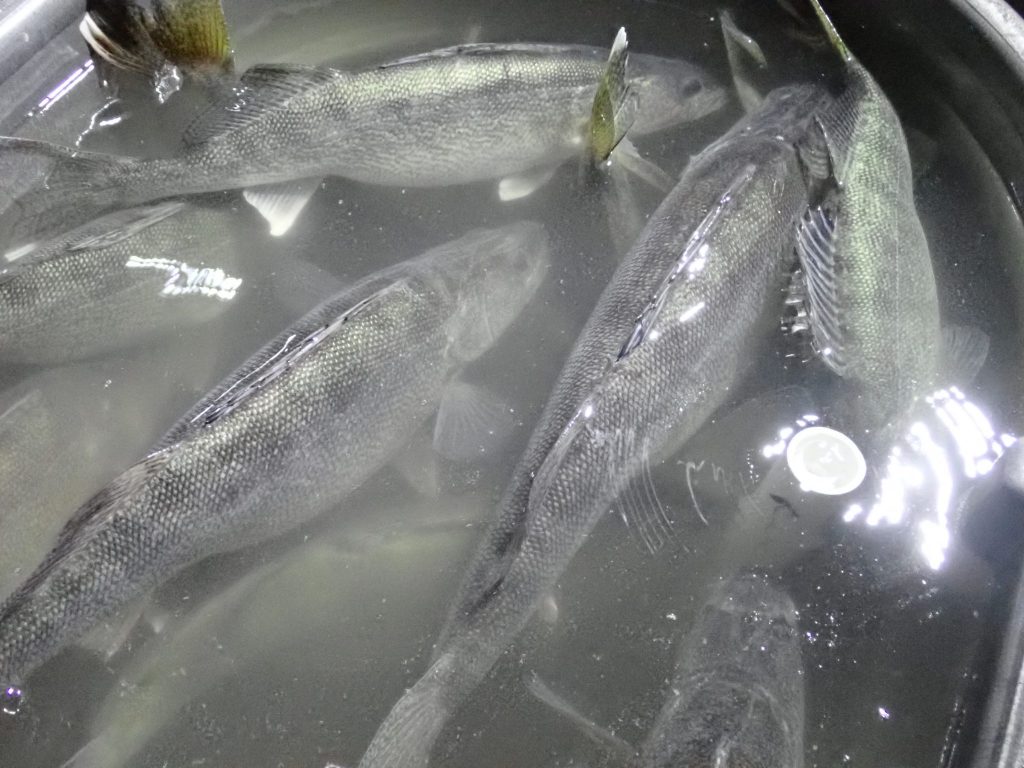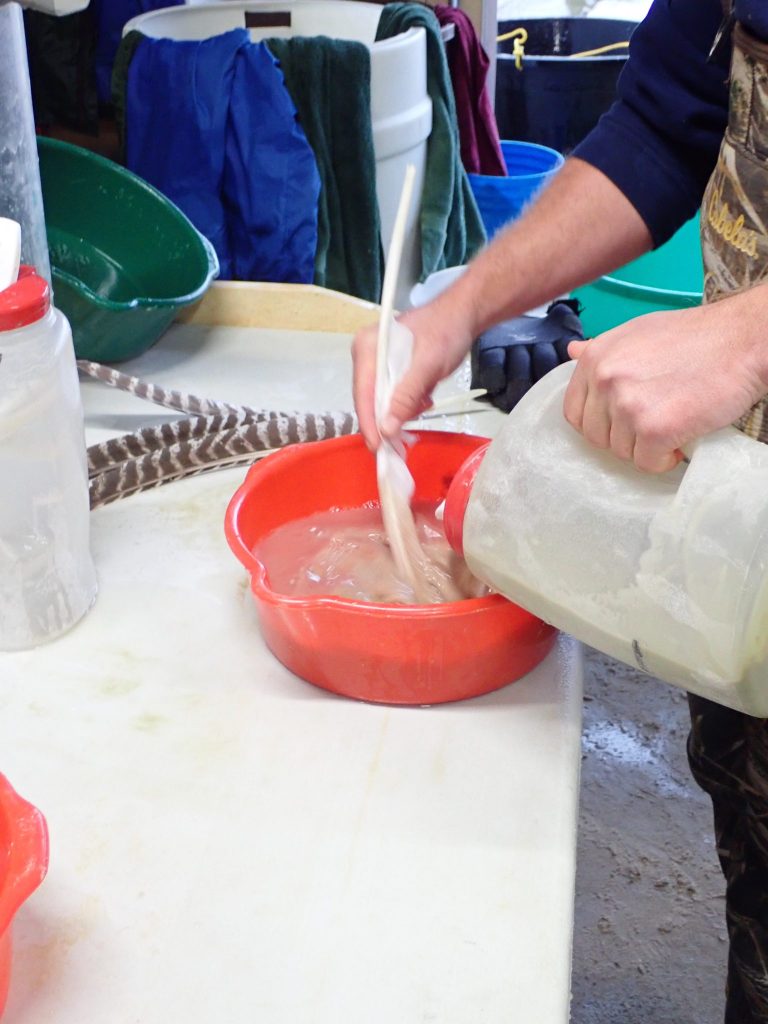I noted a couple of weeks ago that when spring rolls around I actually get outta the office and do a little field work. Even though the water is cold and the weather can be more wintry than springy, I look forward to it every spring! One of those activities is the annual collection of walleye eggs that our Nebraska fisheries staff does around the state. Walleye eggs are collected and fertilized in order to produce the fish needed for stocking in waters all over the state. I slipped out for a few days to assist with that effort again this spring and even though I have blogged about it before, let me do it again (there might be new folks reading this, and besides I know people ALWAYS like seeing pictures of big fish!).
There can be several things that cue the timing of spawning activity in fish. Yes, weather and water temperature can be an influence, but I believe the amount of daylight or photoperiod is the main cue for walleye spawning in Nebraska waters. For that reason, I always say the walleyes spawn April 1. Sure there is some variability from one waterbody to another and from one year to another, but we have been collecting walleye eggs for a long time and April 1 the walleyes are spawning. I have seen the walleye spawn in full swing April 1 literally the day after the ice went out, and I have seen it in full swing April 1 when we have already had several weeks of mild weather.
We collected all of our walleye eggs from Sherman and Merritt reservoirs this spring. Crews started collecting fish on Sherman April 1, and a week later we started efforts at Merritt. I also always say that not all fish in a population spawn at the same time, some spawn early, some spawn late, and the entire spawn period for a population lasts over a period of weeks. Within that spawn period there may be several peaks of spawning activity when for whatever reasons the conditions are optimum (usually there are no explanations for those peaks in spawning activity, only the fish know, and they have not told me why, yet). From what our crews saw this year, we were collecting eggs at both Sherman and Merritt at just the right times because we collected a lot of fish, and a lot of eggs, in a short period of time. We like it that way because we can get our work done in the shortest amount of time, and get home before the next spring blizzard hits.
I slipped out to Merritt to assist for a couple of nights. The collection of fish occurs at night because, well, they are walleyes and they are active in low-light conditions and after dark. Most walleye spawning activity takes place after dark. I always say that the males come early and stay late, and it is easy to fire up an electrofishing boat and in less than an hour collect all the males needed to fertilize the eggs from several hundred females.

The collection of females takes a little more effort. Large-mesh gill nets are used to specifically target females (most, but not all, males are small enough that they go right through the gill net). Nets are set around sunset.
Yes, of course it is always a beautiful night. They are all like this:
An hour or two later the gill nets are pulled, female walleyes removed.
This is how you know it has been a good night, when the livewell is full of female walleyes!
The first two nights at Merritt our crews collected 261 and 278 female walleyes. A number of those fish were “green” not quite ready to spawn yet, but certainly we were in the middle of some peak spawning activity.
During the night, fish are hauled from the nets back to holding cribs where they are kept until morning. At that time another crew shows up to do the actual egg collections. Cribbed females are sorted for “ripe” fish that are ready to spawn.
But first, we gotta get the boys ready. It ain’t rocket science, but it is fisheries science. . . .
A person can fertilize the eggs directly by taking males and expressing their milt right into a pan full of eggs. However, over the years pointy-headed fish biologists and fish culturists have learned that we can increase the fertilization rate of the eggs by diluting the sperm. “Timeliness and Distribution” are key!
How is that done?
Well, first we collect milt from males:
Milt is sucked from the males and collected in a vial.
The result is a flask full of walleye milt collected from several males. All of it is kept cool.
Milt is then divided into tubes.
The milt in each tube is diluted with an “extender” solution, a sugar and salt solution. That dilution allows for better distribution of sperm in a pan full of walleye eggs, and that is how we get a higher fertilization rate, up to 75% or even better.
Once the milt has been prepared, it is time to start squeezing ripe females.
You might notice the towels. They are very important; let me explain: Yes, we love our walleyes and want them to be warm and comfortable. No, that is not it . . . . Yes, we love our walleyes, but they do not need to be warm. Again, it is all about maximizing fertilization rate. Fish squeezers spawning walleyes use what is called a “dry fertilization technique”. As much as possible, the eggs and milt are kept free of water until they have been mixed together. Sperm is not activated until it comes into contact with water! So, again it is all about “timeliness and distribution”, and by keeping as much water as possible OUT of the spawning pans, until everything is mixed, we can insure the highest rate of fertilization. So the females are patted dry before their eggs are expressed into dry pans.
Then a vial of milt is added to the pan, 
a feather is used to mix the eggs and milt, water is added to activate the sperm.
And then we ruin all the just-fertilized eggs by dumping muddy water on top of them.
Not! Seriously, a slurry of Fuller’s earth or diatomaceous earth is added to the fertilized eggs, and stirred, because the eggs will clump together. Clumps of eggs tend to develop fungus and die before they hatch. By coating them with fine clay, the clumping is prevented, and the eggs can develop and hatch.
At Merritt we have a spawning shack right at the reservoir where the eggs are immediately placed in jars on a hatching battery to rinse off the clay slurry.
At the end of the morning, several dozen quarts of walleye eggs get loaded into coolers for transport to hatcheries where the eggs will be placed in other hatching jars on other hatching batteries.
In a couple of weeks the eggs will hatch, some will be stocked soon after that, some will be grown in hatchery ponds for approximately forty days before stocking, and a few will be raised to even larger sizes before being stocked next fall.
Look real close, here is that walleye you are going to catch in a few years:
And here is what her momma looked like.
The post Walleye Spawn 2019 appeared first on Nebraskaland Magazine.































